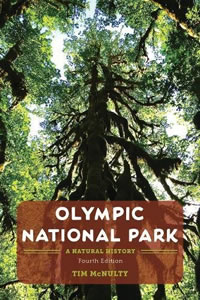 “Olympic National Park: A Natural History” was first published in 1996. Author Tim McNulty and University of Washington Press have now come out with the fourth edition (2018). It’s no wonder this book has been so popular. McNulty is an excellent essayist and the subject is a mostly unspoiled, large-scale ecosystem, from seashore to mountaintops, the latter easily seen on a clear day from Seattle.
“Olympic National Park: A Natural History” was first published in 1996. Author Tim McNulty and University of Washington Press have now come out with the fourth edition (2018). It’s no wonder this book has been so popular. McNulty is an excellent essayist and the subject is a mostly unspoiled, large-scale ecosystem, from seashore to mountaintops, the latter easily seen on a clear day from Seattle.
This is not an identification book or field guide. There are photographs, but they mostly set the mood of the book by being clustered up front. Instead, this a reading book, intended to be savored cover-to-cover, to gain an understanding of the flora and the fauna in broad settings: the mountains, the forests, and the coast. The author concludes with the human history of the region, especially pre-European, and the much more recent struggle to establish and maintain the integrity of the national park and its ecosystems.
This newest edition is the same as the previous (2009) in large part, but includes the story of the removal of dams on the Elwha River. It also updates efforts to restore the animal life as found prior to the influence by European and eastern North American settlers, with the reintroduction of fishers and the removal of non-native mountain goats.
The Olympic Peninsula is sometimes described as a refugia, a place where plant and animal species survived while disappearing from nearby locations. This is in part because of the wide range of topographical niches, caused by extreme changes both in elevation and rainfall over short distances. Species could adapt by moving to nearby, suitable habitats.
Earlier history is part of this story, too. While much of the peninsula avoided glaciation, “the ice age and the climatic upheavals that preceded them have reshuffled the deck of plant and animal communities wildly in the Olympic Mountains…alpine and sub-alpine species mixing willy-nilly with lowland plants and varieties.” This gives hope that these mountains and lowlands will continue to provide refuge for plants during future climate change.
Excerpted fom the Spring 2019 Arboretum Bulletin.